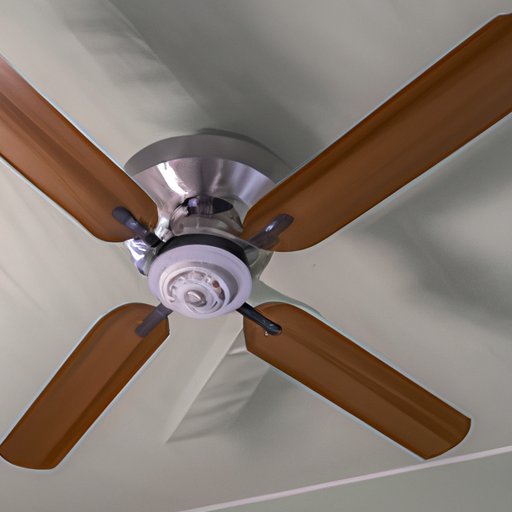Introduction
Ceiling fans have been around since the late 1800s, providing much needed relief from heat during the summer months. Today, ceiling fans are more than just a way to keep cool; they can also provide an aesthetic addition to any room. With so many options available on the market, it can be overwhelming to choose the right one. This article will explore how to choose a ceiling fan, offering tips and advice on what to consider when making a purchase.

Research Different Types of Ceiling Fans
The first step in choosing a ceiling fan is to research the different types available. There are a variety of sizes, shapes, and styles, so it’s important to narrow down your choices based on your needs and preferences. Here are some things to consider:
Consider Size
Ceiling fans come in a range of sizes, from small to large. Smaller fans are ideal for smaller spaces, such as bathrooms, while larger fans are better suited for larger rooms, like living or dining rooms. It’s important to measure the space you plan to install the fan in before making a purchase.
Consider Shape
Ceiling fans come in both round and square shapes. Round fans tend to be more traditional, while square fans are more modern. Consider the overall design of the room and choose a shape that complements the existing decor.
Consider Style
The style of the ceiling fan is also important. Traditional styles typically have wooden blades and muted colors, while modern styles often have metal blades and bright colors. There are also specialty fans available, such as industrial or vintage-style fans. Think about the overall look you want to achieve and choose a style that fits.
Evaluate Your Room’s Size and Space
Once you’ve narrowed down your choices, it’s time to evaluate your room’s size and space. This will help you determine the appropriate fan size for your needs. Here are some steps to follow:
Measure Height
Measure the height of the ceiling in the room where you plan to install the fan. This will help you determine the appropriate fan size. The higher the ceiling, the larger the fan should be.
Measure Width
Measure the width of the room as well. This will determine the number of blades the fan should have. For example, smaller rooms may only need three blades, whereas larger rooms may require more.
Determine Appropriate Fan Size
Once you’ve measured the height and width of the room, you can then determine the appropriate fan size. Generally, the larger the room, the larger the fan should be. Keep in mind that larger fans will require more power, so make sure you have enough electricity to support the fan.

Test Out Different Fan Speeds
When shopping for a ceiling fan, it’s important to test out the different fan speeds. Most fans come with multiple speed settings, allowing you to adjust the fan according to your needs. Make sure to test out each setting to ensure the fan is working properly.
Look for Multiple Speed Settings
Look for fans that have multiple speed settings. This will give you the flexibility to adjust the fan according to your needs. Some fans even come with remote controls, making it easier to adjust the fan without having to get up.
Adjust Fan According to Needs
It’s important to adjust the fan according to your needs. If you’re looking for a gentle breeze, opt for a slower speed setting. If you’re looking for more air circulation, opt for a faster speed setting.
Look for Energy Efficient Models
When shopping for a ceiling fan, it’s important to look for energy efficient models. Look for fans that are Energy Star certified, as these are designed to be more energy efficient than other models. Energy Star certified fans use less energy and can help save on energy costs.
Look for Energy Star Certified Models
Look for fans that are Energy Star certified. These fans are designed to be more energy efficient and can help save on energy costs. They also come with extra features, such as remote controls and multiple speed settings.
Consider Safety Features
When shopping for a ceiling fan, it’s important to consider safety features. Look for fans that come with blade guards and reverse switch options. Blade guards help keep fingers and other objects away from the blades, while reverse switch options allow you to change the direction of the fan.
Look for Blade Guards
Look for fans that come with blade guards. These guards help keep fingers and other objects away from the blades, reducing the risk of injury. Be sure to check the manufacturer’s instructions for proper installation.
Look for Reverse Switch Options
Most ceiling fans come with reverse switch options. This allows you to change the direction of the fan, which can be beneficial during different times of the year. In the winter, for example, you can set the fan to run clockwise to circulate warm air throughout the room.
Conclusion
Choosing a ceiling fan can be a tricky process. It’s important to research different types of fans, evaluate your room’s size and space, test out different fan speeds, look for energy efficient models, and consider safety features. By taking the time to do your research, you can ensure you choose the right fan for your needs.


